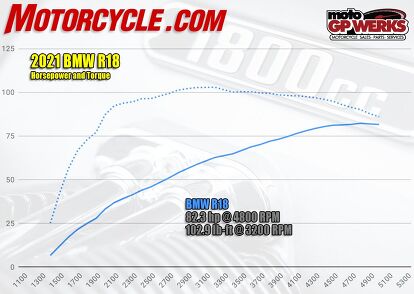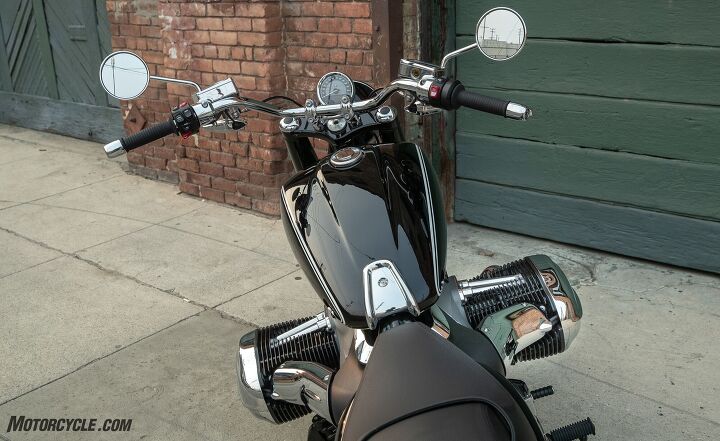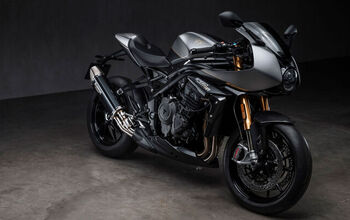2021 BMW R18 Review - First Ride

BMW goes all-in on the cruiser market with the biggest Boxer ever
BMW has been teasing us for quite a while, and now that we have it in our hands, the 2021 BMW R18 truly is a thing of beauty. Rolling motorcycle art, if you will. Just walking around the bike slowly taking in the detail work that this embodiment of BMW’s past heritage wrapped in modern technology is a visual feast. From the exposed shaft drive to the polarizing fishtail exhaust to the chromed-out master cylinders of the First Edition trim to the modern headlight in a vintage shell, the R18 exudes quality. Starting the 1802cc oil/air-cooled boxer Twin sets the whole bike rocking side-to-side at the 950 rpm idle speed, pulsing like it’s alive.
2021 BMW R18
| Engine | 18.0/20 |
| Suspension/Handling | 10.5/15 |
| Transmission/Clutch | 9.0/10 |
| Brakes | 8.5/10 |
| Instruments/Controls | 4.5/5 |
| Ergonomics/Comfort | 7.0/10 |
| Appearance/Quality | 10/10 |
| Desirability | 8.5/10 |
| Value | 8.0/10 |
| Overall Score | 84/100 |
BMW Releases Details On “Big Boxer” R18 Engine
With all these positive attributes surrounding this initial release of the R18, I had to wonder why, after riding it the first time, I wasn’t more excited by the bike. With BMW following the unusual order of providing me with the bike before briefing me or giving me the media kit, I attended the virtual media introduction with this question in mind, and by the time I exited the Zoom meeting, I think I found my answer.
BMW considers the R18 to be the company’s first foray into the cruiser market. When the R1200C was inevitably brought up by one of the briefing’s attendees, the response served as both the truth and a deflection at the same time. According to Edgar Heinrich, Chief Designer BMW Motorrad, the R1200C wasn’t really a cruiser (that we can all agree on, even if the C was supposed to mean cruiser), which makes the R18 the motor company’s first release of a cruiser. (I’ll leave that for you to decide.)
Regardless, BMW learned from the R1200C and spent four years developing the R18, complete with extensive market research with owners of premium large-displacement cruisers about what makes a motorcycle a cruiser. The key elements of cruiser design should come as no surprise to anyone who has followed cruisers for the last couple of decades.
According to BMW the features that defined a cruiser could best be summed up by the R18’s direct competitor (or is it inspiration?), the Harley-Davidson Softail Slim. The stance is long and low with a double cradle frame leading to a hardtail-look swingarm. The engine is a Big Twin, in the case of the R18 a horizontally-opposed Boxer Twin displacing the magic number of 110 cubic inches. The open driveshaft harkens back to the 1936 BMW R5 that serves as much of the DNA for the R18’s styling, pointing out that Harley isn’t the only marque with some serious heritage to draw from for a modern interpretation.
The Big Boxer
While we wrote about the R18’s engine when the specifications were announced last November ( here), the major points of the Big Boxer bear repeating. First, while the Boxer design is quite old, the Big Boxer is a thoroughly modern engine. It has to be to pass Euro 5 regulations. To that end, the 107mm x 100mm cylinders feature four valves per cylinder which are operated by pushrods, themselves triggered by a pair of camshafts positioned above the crankshaft on either side of the engine. This setup allows for shorter pushrods and less mass in the system. Intake manifold injection meters the fuel while dual spark plugs initiate the party for a cleaner burn. All of this is overseen by the ECU, which is tuning the prodigious torque delivery to the tune of 102.9 lb-ft at 3,200 rpm, but the kicker is that the flat torque curve stays above 90 lb-feet from roughly 2,500 rpm to 4,000 rpm. Nice!
To deliver the power to the rear wheel, the engine uses a single disc dry clutch with a slip-assist system to prevent wheel hop under heavy deceleration. Additionally, the ECU modulates the butterflies to help mitigate some of the abrupt engine braking that large-displacement Twins exhibit.
The ride-by-wire throttle gives the R18 the ability to have ride modes, and BMW’s designers showed their sense of humor with the mode names: Rock, Roll, and Rain. In my experience, Rock, the most aggressive of the modes, has such smooth throttle response that it would be my only choice unless it’s wet out. The ECU is so well sorted that, try as I might, I couldn’t get it to hiccup rolling out of and back into the throttle. The fuel metering is simply flawless. John Burns will be disappointed to learn that, for now, the R18 does not have cruise control available, although it will become an option at a future date.
The chassis
The R18’s frame is about as traditional as they get. The steel double-cradle is attached to a central backbone, and in a nod to the rigid tail sections of yore, the swingarm carries on the line of the backbone for a hardtail look while still offering full suspension. The preload-adjustable shock lays horizontally, directly connecting the top of the swingarm to the main frame. With only 3.5-inches of suspension travel and no linkage, the ZF Sachs shock is given a challenging task of absorbing bumps in a short stroke. In the front, a non-adjustable 49mm conventional Showa fork gets raked out to 32.7° with an ultra-stable trail of 5.9 in.
On the boulevard and beyond
Settling into the R18’s saddle will be, for cruiser fans, a familiar experience. The 27.1-inch seat height puts it at the low end of the spectrum, giving shorter riders an easy reach to the ground. Thumbing the starter momentarily torques the bike to the left surprisingly strongly, even for those of us who are quite familiar with Boxer engines. Then the engine settles into a lumpy idle that should put a smile on any rider’s face.
Pulling away from a stop reveals a clutch that engages early in the lever travel but not abruptly. The slip-assist clutch means that riders don’t need a gorilla grip to manage the clutch. The Big Boxer loves being short shifted around town, loafing at the bottom of the rpm range while still providing plenty of acceleration. Gear shifts are slick and easy.
The riding position is ideally suited for around town jaunts, and BMW says that the R18’s target rider prefers short hops to longer rides. The rider’s torso is held upright by the pulled back handlebar. Although this is comfortable around town, the rider is left to fight the wind at highway speeds. I ended up leaning back and letting my skeletal system support me on longer freeway stints. The engine, however, could loaf along the interstate for days, ticking over just 2950 rpm at an indicated 80 mph.
And now about the lower body. There’s a reason that Harley pairs a feet-forward riding position with low seat heights. On the R18, with its mid-mount pegs, the rider’s legs are pretty cramped (I have a 32-inch inseam.). Yes, the cylinders leave BMW little option in the peg placement, but the seat height is a design choice that could help remedy this situation.
With a 68.1-inch wheelbase, stability is the operative word to describe how the R18 comports itself. Still, the bar offers enough leverage to bend into corners. Side-to-side transitions are easier than one might expect from a long, heavy motorcycle. However, the grinding of footpegs ends the cornering party much earlier than I would have liked. This isn’t just an occurrence when out on the winding roads that most R18 owners will rarely visit, though. The pegs touch down when cornering smartly in town, too. The desire for a low seat height and a slammed appearance of the back of the bike are the root of this leaning limitation.
Similarly, keeping the saddle just 27.1 in. off the tarmac limits the amount of travel available to the rear suspension. Having only 3.5 in. of travel to absorb road irregularities is a tough job. On smooth pavement, the firm ride feels a bit sporty. Unfortunately, bumps become harsh very quickly as they overwhelm the shock’s ability to damp them. Sadly, the cruiser obsession with the absolute lowest seat height has claimed two victims: lean angle and rider comfort.
Braking is one area that BMW went gunning for the competition. The designers noted that most cruisers get by with just a single front disc. The R18 steps things up with twin 300mm discs squeezed by Brembo four-piston, axially-mounted calipers. The rear wears a single version of the same disc and caliper. The front and rear calipers are linked and controlled by the ABS module, meaning that when the front brake lever is pulled, the rear caliper is also activated. You are able to apply the rear brake only, though. Although the brakes do work better than the majority of cruiser binders, the initial free play of the front lever took some getting used to.
What would a BMW motorcycle be without a few optional features? The $1,450 Premium Package gives the rider Hill Start Control and Reverse Assist. The Hill Start Control works just as you’d expect. After you set the brakes on a hill, the rider can release them, and the R18 will hold the bike’s brakes until it senses that you’re moving forward under the engine’s power. With a measured weight of 787 lb., the R18 can be tough to back out of a parking space if the pavement isn’t perfectly flat. With the engine running, simply put the transmission in neutral, flip a lever by your left foot, and then press the start button to ask the starter motor to do the work for you.
Going all in
While I can’t question the definition that BMW arrived at for what makes the essential characteristics of a cruiser, the question of “why now” immediately comes to mind. Harley-Davidson’s sales are in a multi-year contraction and, over the past decade, the Japanese manufacturers have all but abandoned the metric cruiser market, leaving those models that are still being sold unchanged for years. Although Indian, being another American manufacturer, has made inroads into Harley’s market, it appears to be battling for the same shrinking demographic. However, BMW’s brass thinks that a younger, early 40s age group the company is looking to capture with the R18 isn’t as brand loyal as previous generations. Instead, they are open to something different as long as it meets certain criteria. “This is our time to shine in this segment,” said Vinnie Kung, Product Manager, BMW Motorrad USA.
Which brings me back to my initial feelings after riding the R18 for the first time, it’s a fine bike that hits all the points of what an American-style cruiser should embody. Just look at the profile of the R18 (and its target, the Softail Slim). It has beautiful, classic sloping cruiser lines bookended by fat tires on spoked wheels. The Big Boxer provides the Beating heart of a Twin. The seat is low, and the riding position is upright with the feet somewhat forward. The fit and finish are exactly what you expect from a premium brand. This is no sticking a toe in the cruiser water to see what it is like; this is commitment.
However, from the saddle, the R18 is just a little too much Harley (3.5 in. of rear suspension travel, limited ground clearance) and not enough BMW. This unquestionably beautiful motorcycle has all the design cues of a motorcycle that can trace its heritage all the way back to 1936 and the R5, but the R18 lacks the performance chops that have made modern BMWs what they are – in this rider’s opinion.
Nonetheless, I’m quite interested in what BMW has in store for this line of motorcycles. Yes, BMW have said – without any other details – that this will be a family of cruisers. (For proof, just look at these spy photos.) A few tweaks will make the R18s a family to watch in the future. For now, the 2021 BMW R18 is available in your local dealers, starting at $17,495 ($19,870 for the First Edition). If you want a fully loaded R18, like the one I tested, it’ll set you back $22,120 ($17,495 base, $2,150 First Edition, $1,450 Premium Package, $775 Select Package, $250 Passenger Kit).
2021 BMW R18
+ Highs
- 103 lb-ft of torque at 3,200 rpm!
- Authentic, not manufactured, heritage
- Impeccable attention to detail
– Sighs
- Harsh rear suspension
- Cylinders limit foot location
- The shapely seat is quite hard
In Gear

- Helmet: Shoei GT-Air II $699
- Jacket: Alpinestars Oscar Charlie $650
- Jeans: Reax 215 Denim Riding Jeans $199
- Boots: Rev’It Regent H2O $350
Gloves: Royal Enfield Vented Not Available
2021 BMW R18 Specifications | |
|---|---|
| MSRP | $19,870 base, $22,120 as tested |
| Engine Type | 1802cc, air/oil-cooled boxer Twin |
| Bore and Stroke | 107.1 mm x 100.0 mm |
| Fuel System | Electronic intake pipe fuel injection |
| Compression Ratio | 9.6 :1 |
| Valve Train | OHV |
| Max Torque | 102.9 lb-ft @ 3,200 rpm, measured, rear wheel |
| Max Horsepwer | 82.3 hp @ 4,800 rpm, measured, rear wheel |
| Transmission | 6-speed |
| Final Drive | Exposed shaft |
| Front Suspension | Telescopic fork, 4.7-inches of travel |
| Rear Suspension | Steel swingarm with central shock strut, 3.5-inches of travel |
| Front Brake | Dual 300mm discs, four-piston axial – mount calipers, ABS |
| Rear Brake | 300mm disc, four-piston axial – mount caliper, ABS |
| Front Tire | 120/70 R 19 |
| Rear Tire | 180/65 B16 |
| Rake/Trail | 32.7° / 5.9 in. |
| Wheelbase | 68.1 in. |
| Seat Height | 27.1 in. |
| Measured Curb Weight | 787 lb. |
| Fuel Capacity | 4.23 gal. |
| Available Colors | Black |
Become a Motorcycle.com insider. Get the latest motorcycle news first by subscribing to our newsletter here.
We are committed to finding, researching, and recommending the best products. We earn commissions from purchases you make using the retail links in our product reviews. Learn more about how this works.

Like most of the best happenings in his life, Evans stumbled into his motojournalism career. While on his way to a planned life in academia, he applied for a job at a motorcycle magazine, thinking he’d get the opportunity to write some freelance articles. Instead, he was offered a full-time job in which he discovered he could actually get paid to ride other people’s motorcycles – and he’s never looked back. Over the 25 years he’s been in the motorcycle industry, Evans has written two books, 101 Sportbike Performance Projects and How to Modify Your Metric Cruiser, and has ridden just about every production motorcycle manufactured. Evans has a deep love of motorcycles and believes they are a force for good in the world.
More by Evans Brasfield

























































Comments
Join the conversation
Is BMW still going to make the bagger version? If they do, hopefully it has some more cornering clearance.
There are some things I like about this bike, but tubed tires are an absolute deal breaker...unless cast wheels are a no cost option. I don't see any point for motorcycle manufacturers to continue to put tubed tires on a street bikes.